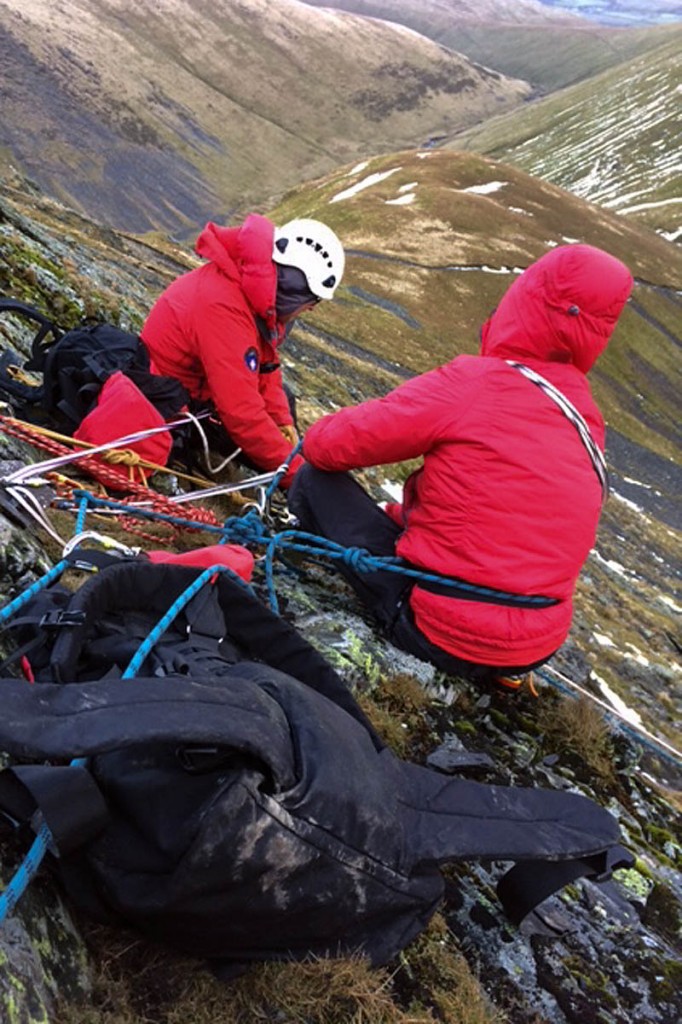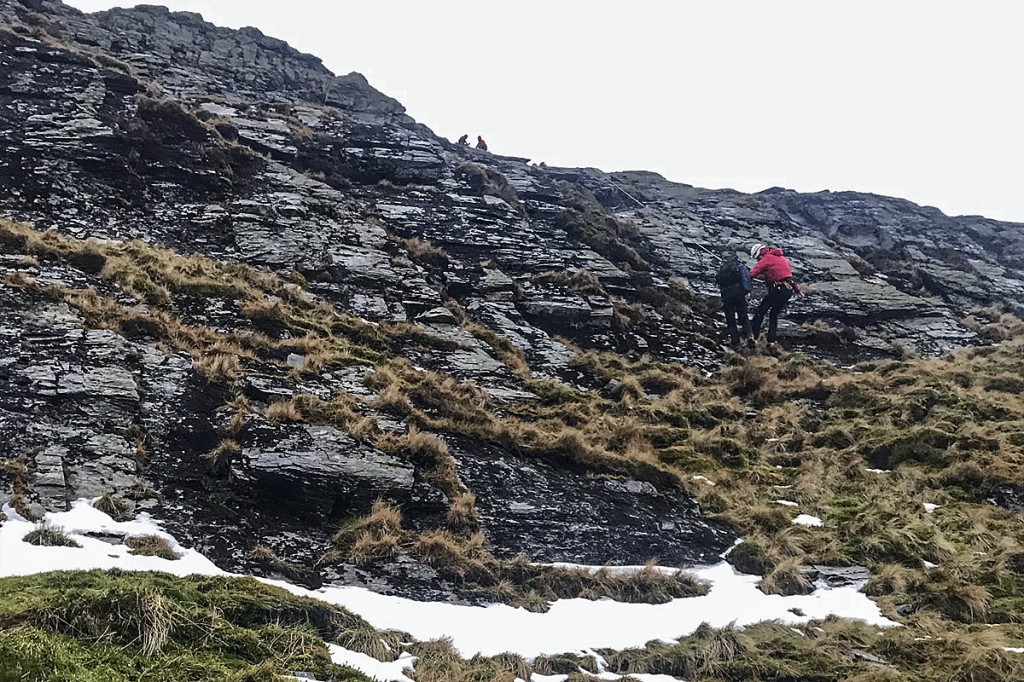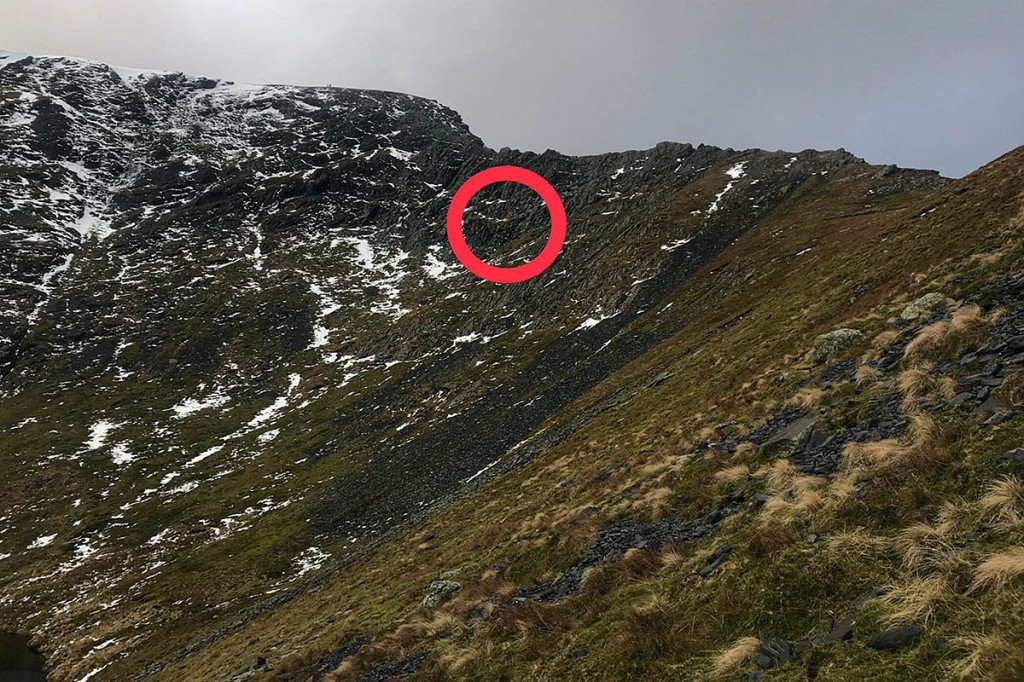Rescuers reiterated the need to be properly equipped when heading for the Lake District mountains in wintry conditions after a couple had to be rescued from Sharp Edge.
Keswick Mountain Rescue Team was called out about 12.40pm on New Year’s Eve to aid the pair who became stuck below the ridge on Blencathra.
Team members had to rig up a rope system to bring the walkers to safety.
A team spokesperson said: “A couple who decided to descend Sharp Edge in winter conditions left the edge itself, and attempted to take a route directly down to the tarn, over a series of icy rock ledges and snow-covered grass patches.
“As they didn’t have the necessary winter equipment, they became cragfast some 60m below the ridgeline.
Unfortunately for them, and us, there was no passer-by to help them out this time, as there had been on [the team’s previous callout] so they ended up sitting it out in the cold for a couple of hours.
“The team in that time had turned out, flogged up to Sharp Edge and rigged the crag to get them off, which took another hour.
“How many times do we need to make the point that winter conditions on any high Lake District fell mean you need the proper kit – ice axe, crampons and proper clothing, ie not jeans?”
The rescue involved 11 volunteers from Keswick MRT and lasted almost 3¾ hours. It was the team’s 99th of the year.



Sandy
01 January 2018Why haven't they been named and shamed.
John Ainsworth
01 January 2018It’s like talking to a brick wall telling these stupid thoughtless people to be properly equipped this time of year,agree named &shamed
Nigel
01 January 2018What good will name and shame do ???? Not much
Agree the behaviours of some people could be better mind
Dave
01 January 2018I wish that some of the walking series/documentaries on TV would point out the dangers instead of going into these areas on nice days and encourage large numbers of inexperienced people up there! Why not go across on an awful day and show everyone just how horrible these places can become. The outdoor celebs have a little bit of responsibility to educate about how uncomfortable these places can become and not just show them in their friendly coats! All in all, other people are being put in danger because of the behaviour of some (or in the case of this area more & more).
Mike V,
01 January 2018Time and time again, we read of incompetent, ill-equipped, ill-prepared people getting themselves into potentially dangerous situations, or worse still, actually getting themselves hurt, and then calling out the local Mountain Rescue Team(s) as a default “get-me-out-of-jail-card”.
I applaud the MRT’s for their continued stoical preparedness to go to the assistance of the innumerable idiots, and equally, for their diplomacy and general verbal restraint, when making public comment on what are termed “avoidable call-outs”. (ACO’s)
You may rightly gather from the following, that I’m not an MRT member, and I don’t have that verbal restraint in what I’m about to say!
How would these fools like it if they were in an MRT volunteer’s shoes? – Constantly called away from family or workplace, having to potentially endanger oneself, in order to rescue thoughtless people who’d got themselves into needless peril?
Genuine accidents are another matter altogether, and are amongst the core reasons why suitably experienced people become MRT members.
ACO’s are not genuine accidents – they are incidents, or “situations”, brought about directly through lack of correct equipment, skills, and preparation.
I’m sorry, but the “Oh we didn’t think that something might go wrong” type of argument just doesn’t wash with me. It’s all too easy to use such trite comments to deflect one’s own shortcomings, and try to put the responsibility for sorting things out on others.
Basic navigation skills are easy to learn, and in all fairness, a map and compass aren’t the most expensive items on the planet!
Similarly, it shouldn’t take genius IQ level to realise that appropriate clothing, equipment, and not least skills for the likely conditions, might be a good idea when contemplating going onto the high fells – at any time of year, let alone the middle of winter!
Dave’s comment (above) makes a good point. If more walking documentaries on TV actually showed how much conditions can deteriorate, and how navigation skills and the right equipment and clothing become absolute prerequisites, instead of making some passing comment that “conditions can quickly change” – without going into what the consequences of such change might be, then it might just get across to some of these people that the hills are not always benign places to be.
OldManOfTheHills
01 January 2018I can only agree with Mike and Dave. Its hard to educate fools but the media stresses romance of the hills, which is true, without mentioning the kit and thought needed.
Perhaps all such honeypot hills and mountains should have a sign at the bottom saying " compass and map advised, in winter headtorch, crampons and iceaxe may also be needed"
Its not the known unknowns that catch us all out its the unknown unknown. We dont want to put people off by simply saying mountains are dangerous, but something like the water awareness campaign might help
Gordon Esslemont
02 January 2018MRT have this unwritten rule about name and shame ie they do what there trained to do without question ,yes they bite their tongue ,frustration sometimes leaks out but very seldom ,respect to each and every one of them past and present for keeping our mountains a safer place to play,so we've had series about the army,police,fire brigade ,ambulance,police interceptors,heli-med 999,coastguard,rnli whole series about the great work they do,Aberdeen/ breamar MRT got a full 30 min one nite ,surely BBC or itv ,sky one etc could do a series of programs relating to map and compass,what to wear,gear ,ice axes,crampons,hats,gloves,etc how to plan a day on the hills ,first aid,boots,socks,cover scotlands 73 mountain rescue veichles ,730 ish MRT members,visit a few of the teams,do a bit on raf,coast guard helicopters ,get the great out doors in the public eye make it stand out like a hi viz jacket and not hidden in the corner,we only hear when it goes wrong ,let's hear about every day heros of the glens like hamish mcinnes,from Glen Coe MRT or Eric Drummond ochils mrt ,Paul Russel from tayside to name a few past and present ,let's do something to get the point over ,a bear is a beautiful thing but don't fuck with it cause it will bite ,bit like the weather conditions in the mountains....
Phil
03 January 2018It's not about naming and shaming but education. As a former Mrt member it often takes great restraint not to let rip at some of these numpties. I finally quit Mrt after 8 years largely due to the changing face of rescues where we were increasingly being tasked to ACOs . There is nothing more frustrating than to leave family and friends for something that was totally avoidable. I like all of my colleagues never had any problems turning out in any conditions to genuine incidents.
nigel
03 January 2018Yes, but what would be the best way to capture everyone that needs educated? I think we all agree they're all adults; in which case, not everyone reads these outdoor websites / forums. Not everyone would watch a TV documentary that talks about the possible dangers etc of walking in the hills. Not everyone reads the outdoor magazines. Not everyone knows an experienced person. Etc etc.
Actually, when I think about it I suspect the 'un-educated' may have little or no interest in taking the time to get educated and you cant force people to listen. "Why bother with all that when I'm only there for the week."
It's easier to educate kids because the one thing they all have in common is that they attend school and are as such a captive audience. Adults with different interests and different ideas of how to spend their time are a difficult thing to educate on mass. Plus and it's a big plus, most people think they're already experts at an activity even before they've tried it.
Alright, despite all that negativity, I agree that education would probably be the best solution. I just don't see how it could be put into practice.
I mean come on, for all those people who have made their mind up to walk up to Bow Fell via Angle Tarn, how many would take notice of a sign at the bottom of Rossett Gill explaining that they should be taking a map and compass with them. I imagine not one single person would see this as a reason to turn back.
Steve
04 January 2018We had a tv series a few years ago which followed the activities of the rescue helicopters, and showed them flying in some pretty terrible conditions, and Nicholas Crane also did a programme where he went up Bidean nam Bian, climbing from a calm Glen Coe into a blizzard on the summit. So it has been done before, I also recollect a TV programme which followed a rescue on Cairngorm, though it might have been in the series about the helicopters.
But it would be good to have a documentary showing what happens on a winter day in the hills.
Getting enough footage of MRT callouts to make a series might be tricky, as someoen would have to shadow them for several weeks to be sure of being around when the calls came.
Chris from Cockermouth
06 January 2018How many people read Grough? As far as I know only regular climbers/walkers.
All these comments ought to be appearing in the 'Red Tops'. Maybe even in the luvvy columns, i.e., Daily Mail ...
nigel
06 January 2018These are relevant comments Chris , don’t understand the daily mail jibe ?????
Ian T
07 January 2018As some folk have said, it doesn't matter if TV programmes are shown to highlight the hazards and consequences of going into our mountains ill-equipped and ill-prepared, there will ALWAYS be people who go regardless because they are either oblivious to the risks, they think they'll 'get away with it' or even worse, they think that a phone call will get them out of trouble.
I know that MRTs will never agree to it but they should be given the option to charge for ACOs and it should be widely publicised so that folk may think twice before they put their lives and the lives of others at risk.
----RANT ENDS-----